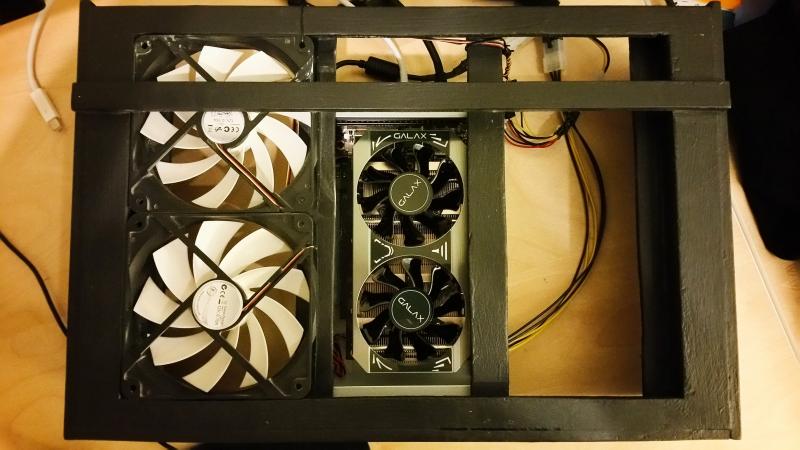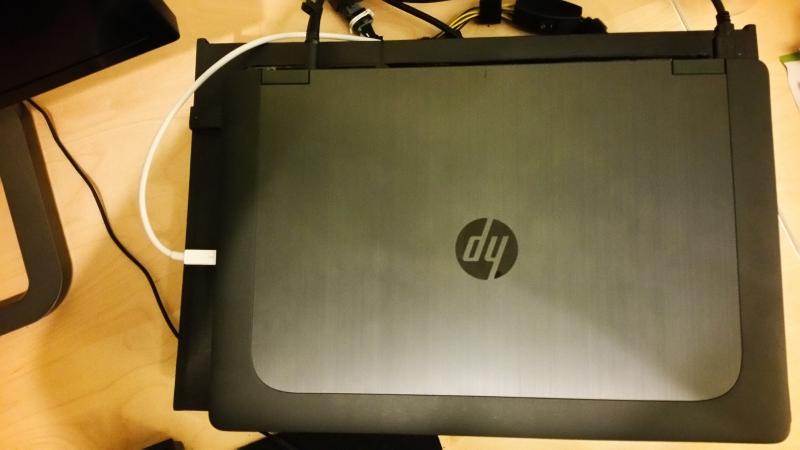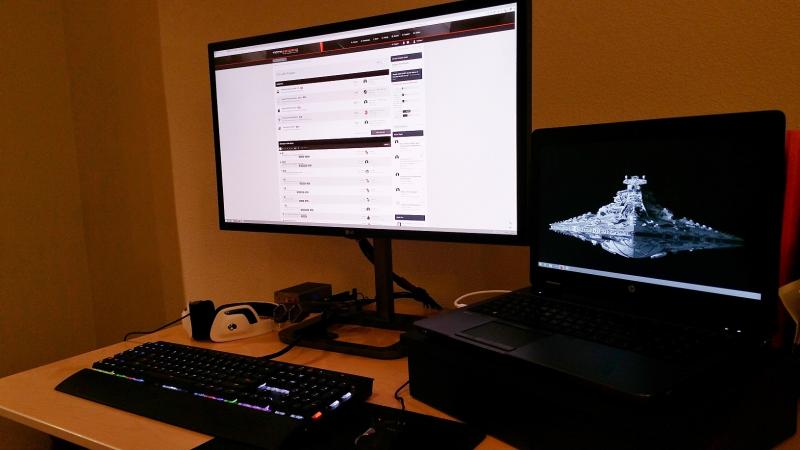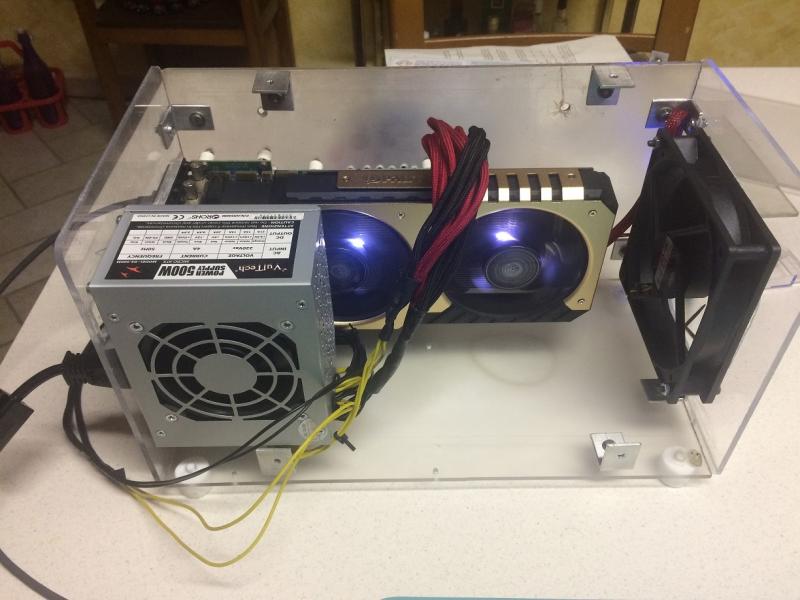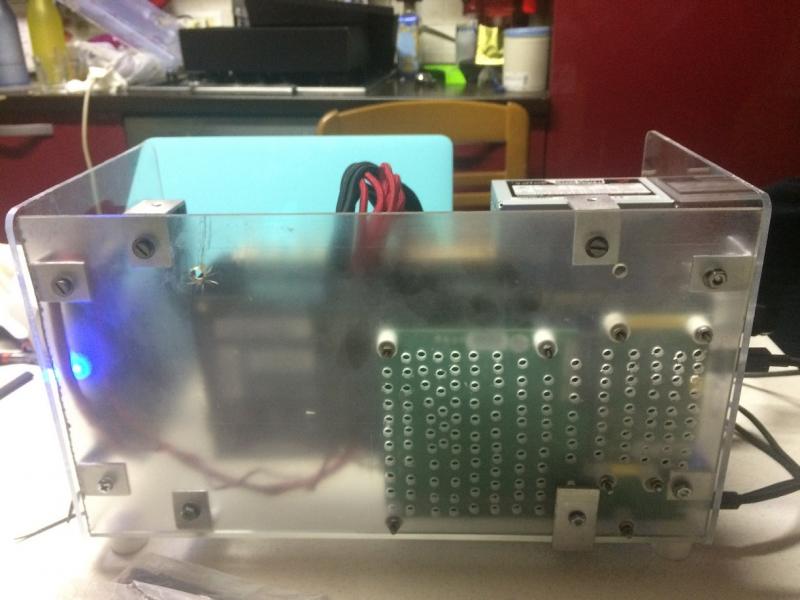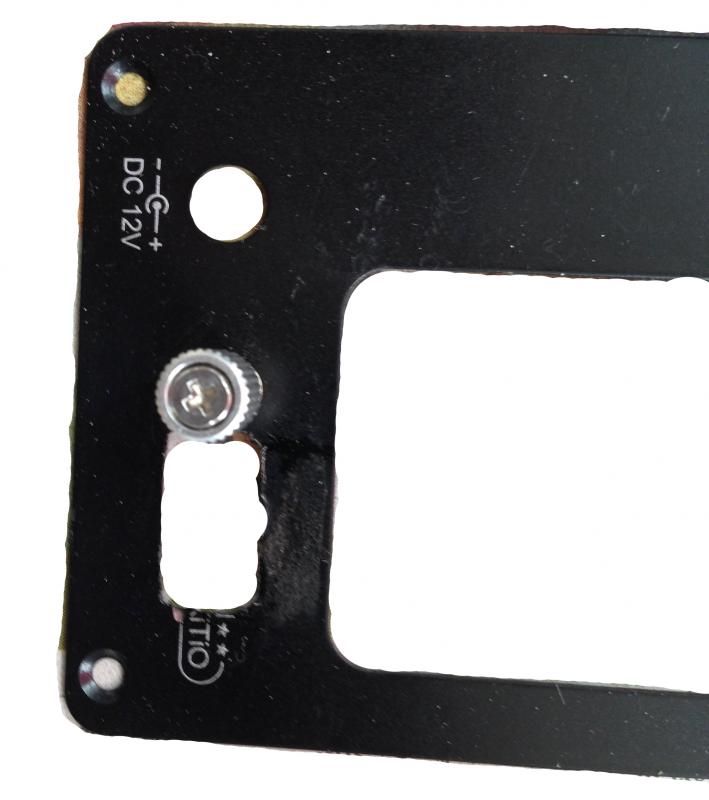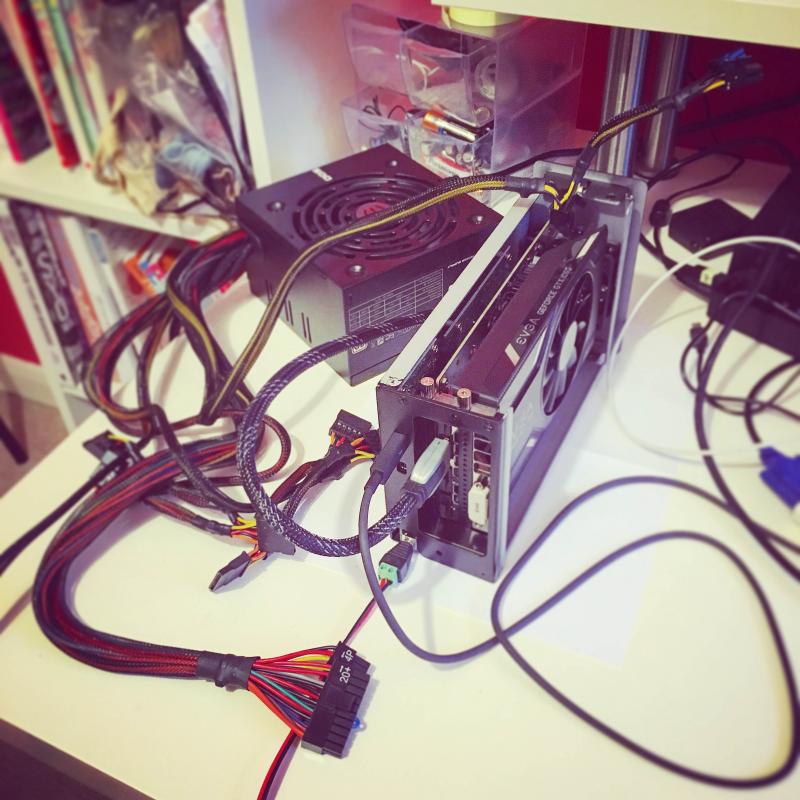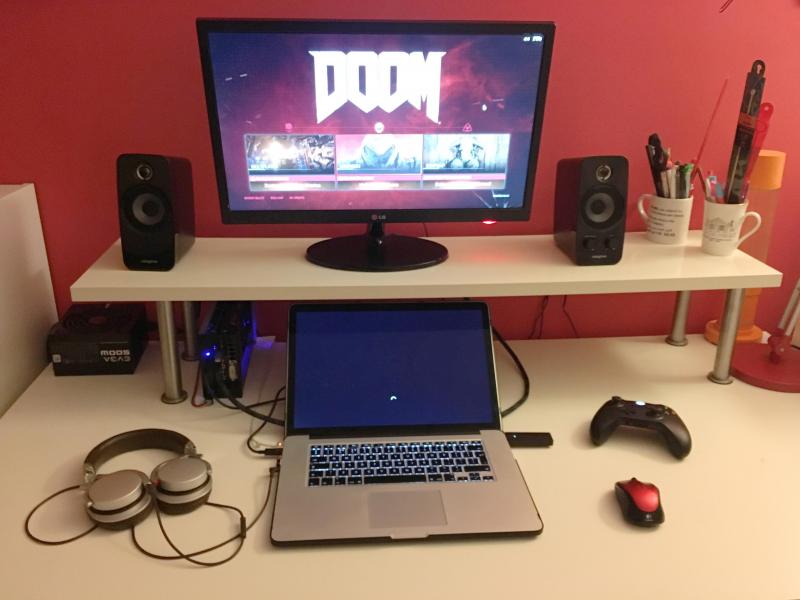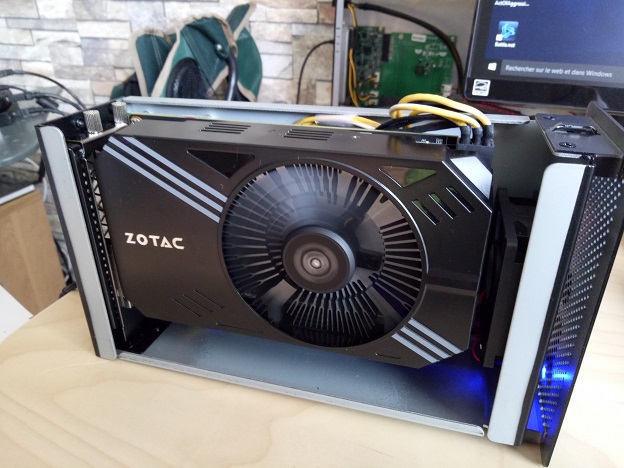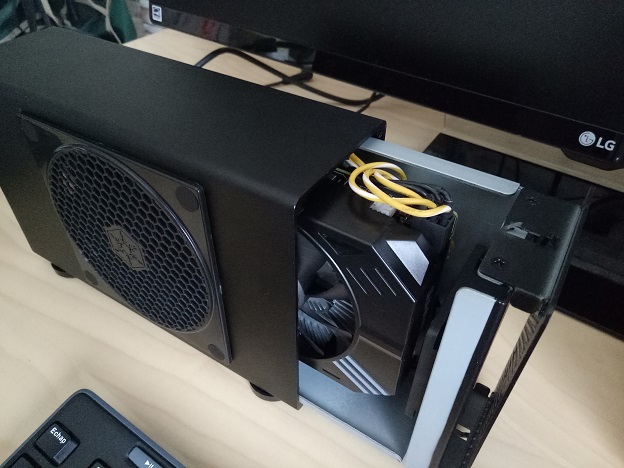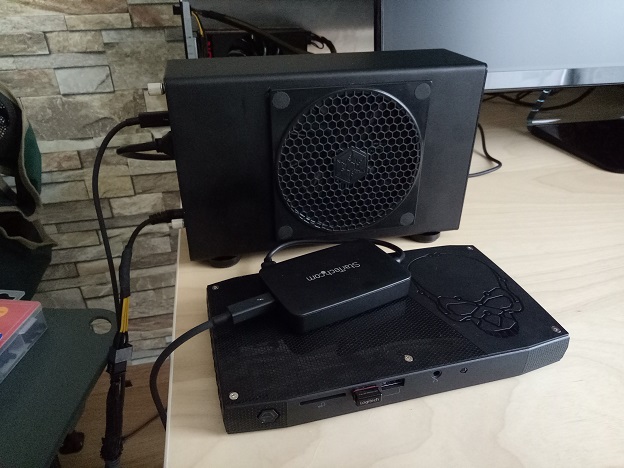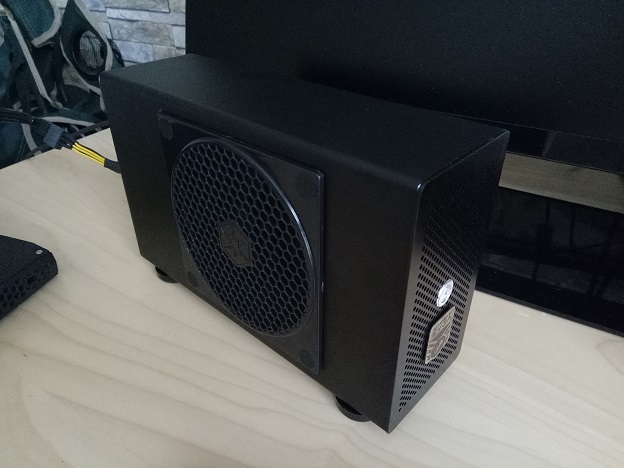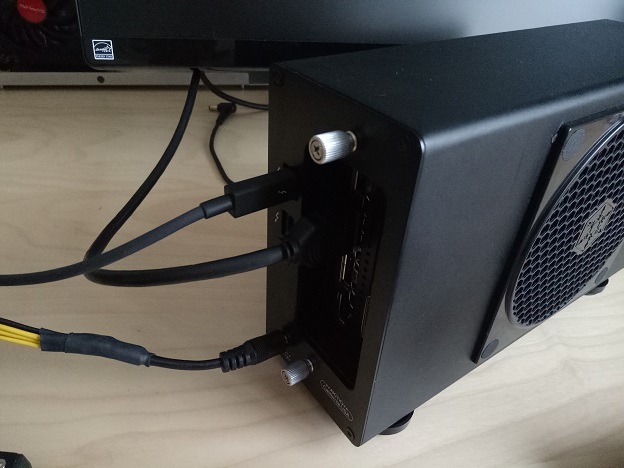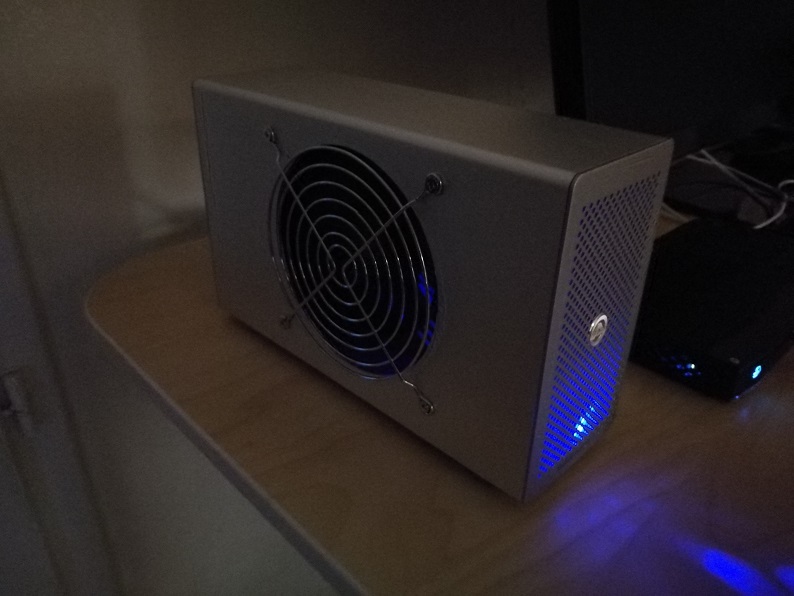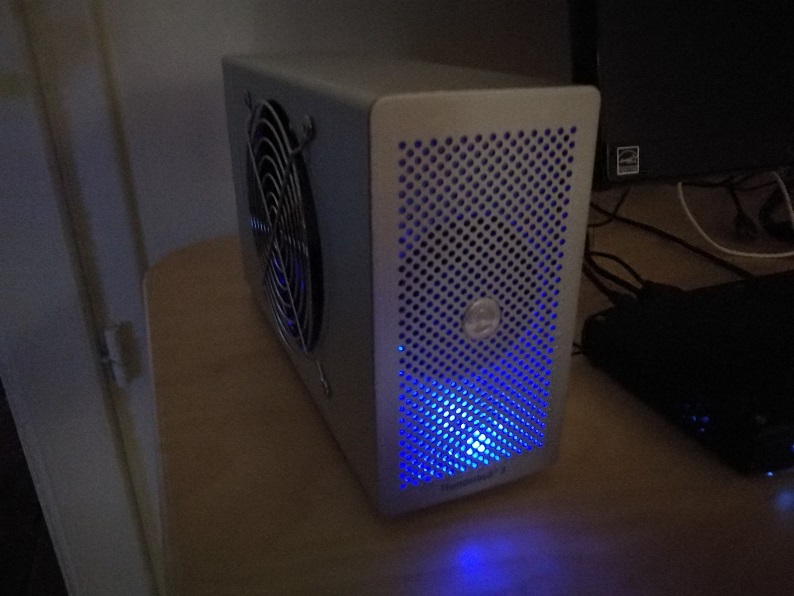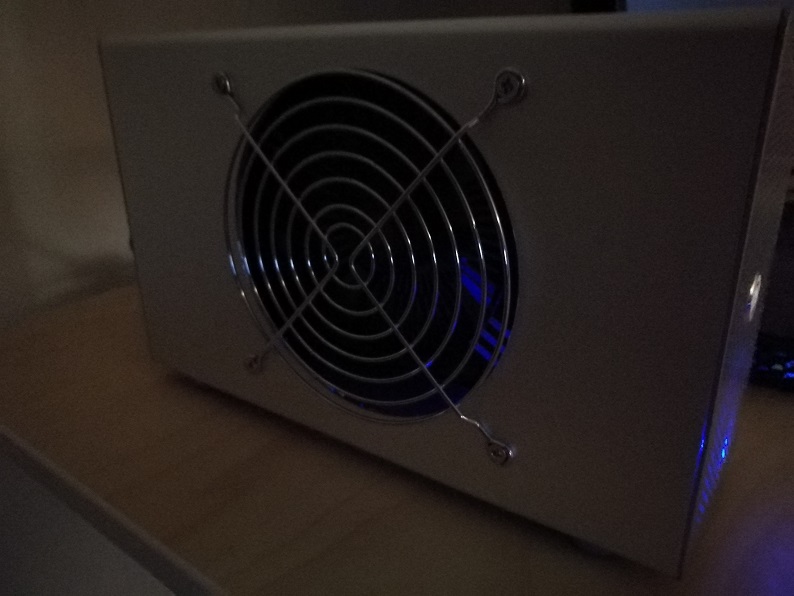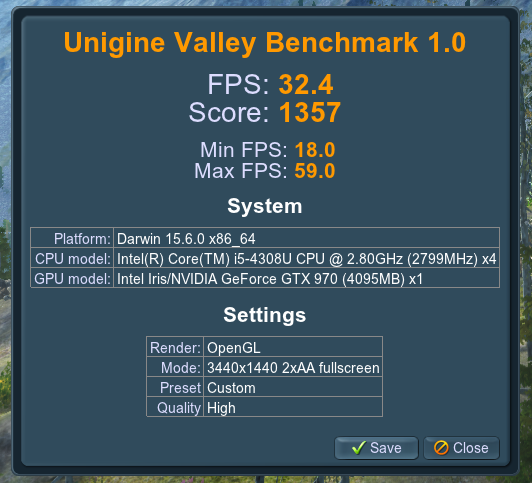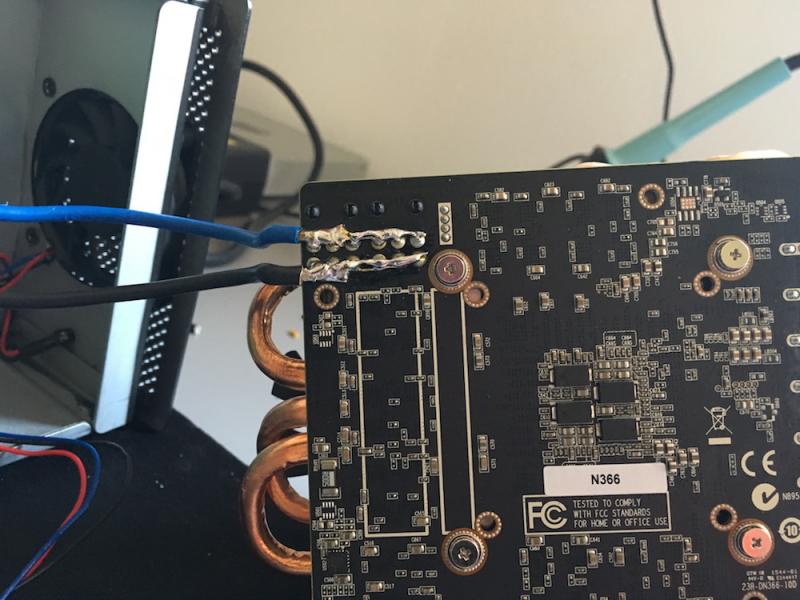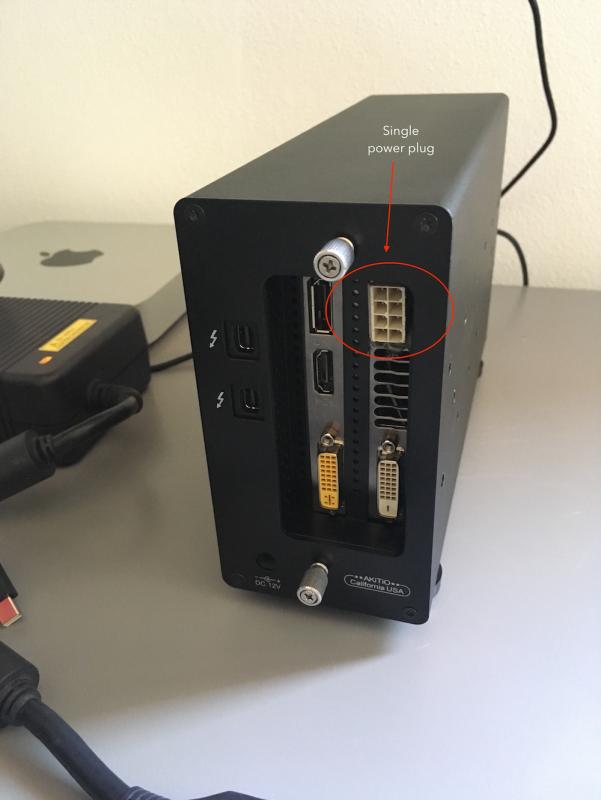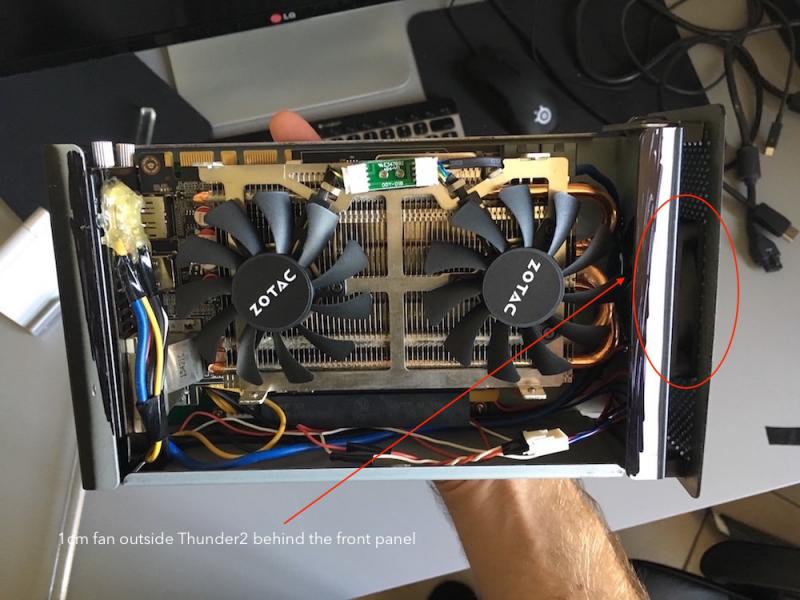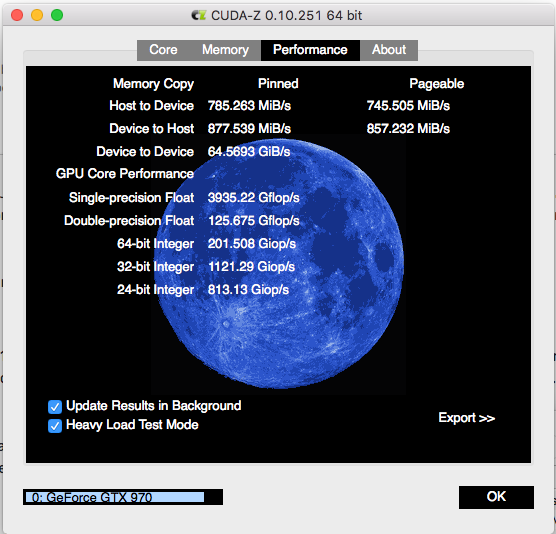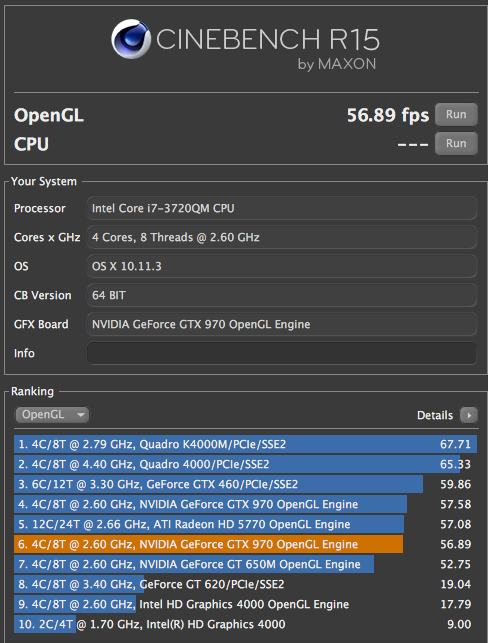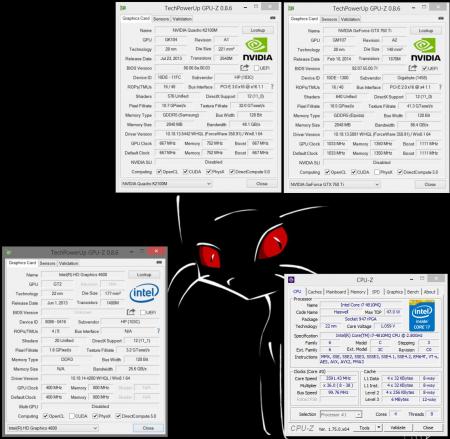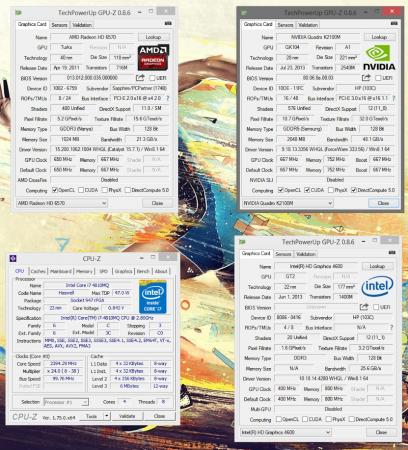Search the Community
Showing results for tags 'akitio'.
-
Greetings! I have MacBook Pro 13" Early 2011 and using EVGA GTX 960 2GB (mini) in Akitio Thunder2 box and Dell DA-2 external PSU. I've installed NVIDIA Web Driver 367.15.10.15f01 to macOS Sierra 10.12.1. Everything works fine, except in some games and benchmarks there are broken / noisy textures like the ones in attached screenshot. What can be the problem?
-
Hi guys, I´m planning to buy Mac Mini to have a second setup with my 970 Zotac + Akitio Thunder 2. I would like an i7 Mac Mini but prices are still high so I´m going to an i5 processor, so I´m trying to decide between to models 2012 i5 2,5 Ghz Thunderbolt 1 or 2014 i5 1,4 Ghz. In one hand the 2012 model is the most upgradable Mac Mini being possible to use 16 GB RAM but it´s Thunderbolt version is 1 on the other hand the 2014 model is not RAM upgradeable but it´s Thunderbolt is version 2. What do you thing? Go to 2012 or 2014? Does anybody can help me? Any benchmarks? Thank you so much!
- 11 replies
-
This is essentially an upgrade of my previous setup from a Gigabyte GTX750Ti 2GB to a Galax GTX960 4GB that was available on clearance for 94$ about a week ago. The Galax GTX960 Mini (but not the EXOC) fits inside the Akitio if you remove the front fan, which in my case is immaterial because I am using the enclosure open, on its side, and using it as a base for my homebuilt laptop cooling pad so that fan was blocked anyway. It takes a single 6-pin power plug which meant that I needed to replace my 180W barrel-plug power supply with something that could feed an extra power connector. The power solution is the ubiquitous 220W Dell DA-2 for 10$ off ebay: I split the connector with a 6-pin PCIe splitter and then soldered a power switch between the sense contact and one of the grounds. That lets me power it up and down easily and avoids paperclips. One of the 6-pin connectors goes into the PCIe 6-pin power on the video card, while the other was split into a 4-pin ATX plug (like the ones used for CPU power on a desktop motherboard) and a regular molex connector that has an independent power switch. The molex is used to power up the fans in the cooling pad (hence the separate power switch for when that is not needed) while the 4-pin connector powers the barrel plug (which has a 4-pin female connector to match). Laptop: HP ZBook 15 G2 Core i7 4810MQ 16 GB DDR3 1600Mhz RAM Intel Pro 2500 480GB SSD nVidia Quadro K2100M 2GB GDDR5 dGPU (Note: The iGPU is disabled in the BIOS) Windows 8.1 Enterprise 64-bit eGPU and External Monitor (I do not run the eGPU with output on the internal screen): Galax GTX960 OC Mini 4GB Dell DA-2 220W PSU Akitio Thunder 2 0.5m Apple Thunderbolt cable LG 31MU97-B (4096x2160) monitor connected to the eGPU via Displayport Setup: As stated in my previous build: This is my work laptop. As a result, I cannot fiddle with boot loaders, replace operating systems and in general I am under the constraints of the whims of the IT department. I suspect that Win10 would be a lot easier to work with here, but alas I cannot upgrade past 8.1, at least for now. This results in the following procedure to get this working once I get home from work. Note that I have the iGPU disabled in the BIOS, as it was giving me some trouble. It is a lot easier to work with just the nVidia driver, as opposed to both the Intel one and the nVidia one. If the laptop is powered off: 1) Connect the Akitio's Thunderbolt cable to the laptop. 2) Power up the Akitio via the DA-2's power switch that I added. 3) Boot up the laptop and log into windows. 4) Either the eGPU will work, or it won't be recognized, or it will be recognized but the external monitor connected to it won't be detected, or it will Code 12. i) If it works: All is great. Enjoy! ii) If it is not recognized: Reboot the laptop, it will work after the reboot. iii) If it is recognized, but the external monitor is not detected: Reboot the laptop, it will work after the reboot. iv) If you get a code 12, then open up the Device Manager, right-click the eGPU and choose "Disable". Then right-click it again and choose "Enable". Windows will prompt you for a reboot and everything will work perfectly after the reboot. If the laptop is on: 1) Power up the Akitio. 2) Connect the Thunderbolt cable to the laptop. 3) Either the eGPU will work, or it will Code 12. 4) If it works, great. If it Code 12s, do the disable-enable trick I described in the "If the laptop is powered off" step 4.iv and reboot. I did not run into Code 43s or any other issues. Removing the eGPU while the laptop is powered up is possible if you disable it in the Device Manager first (since I don't have Windows 10, I don't have the neat nVidia tool to do it directly). Removing the eGPU cable without disabling the device first will lead to an immediate BSoD. The image below shows a view from the top of my cooling pad with the open Akitio at its base. The two fans on the left blow up into the laptop's cooler intakes. The Akitio's floor serves to separate them from the downward airflow from the video card's fans. You can see some of the cabling, but there is a better photograph of the cables in the next post. This is the laptop on top of the cooling pad. The screen is closed and you can see the three cables I need to connect to get all my peripherals working once docked: The Thunderbolt cable (white), the laptop's charger at the top left and the USB3.0 cable leading to the USB3.0 hub in the monitor at the top right. I apologize for the poor lighting, but here you can see the whole setup. The K2100M runs the laptop's internal display, while the GTX960 runs the external one. The laptop sits on top of the cooling pad/eGPU assembly.
-
This is probably the simplest eGPU setup I've dealt with so far. It is also rather silly, since the CPU is definitely the weakest link here. An Ivy Bridge i3 at 1.8Ghz isn't going to push high frame-rates in gaming, after all, and the performance improvement definitely doesn't justify the cost. An actual use for something like this would be to add HEVC decoding abilities to an existing NUC. Just use a cheaper enclosure (such as the 140$ Thundertek one) or opt for mPCIe instead of Thunderbolt to keep the price as low as possible. Obviously the GTX750Ti I used here doesn't decode HEVC in HW, but I suspect a newer low-range video card will work just the same and will do so. I guess I just had to try it. Anyway: Computer Components: Motherboard: Intel DC33217CK (CPU: i3 3217U @ 1.8Ghz) Case: Silverstone PT14 Aluminum NUC Case Memory: 2x4Gb DDR3 1600Mhz Storage: BP4e V2 120GB mSATA SSD Power Supply: FSP 65W NUC PSU OS: Windows 10 64-bit (with the Anniversary Update installed and completely up to date) eGPU Components: eGPU Enclosure: Akitio Thunder2 eGPU Power Supply: 180W Dell Adapter (this is the one that came with my PE4C ages ago) eGPU: Gigabyte Low-Profile OC GTX750Ti (60W TDP BIOS Mod) eGPU Thunderbolt Cable: 0.5m Apple TB Cable This is a truly "this just works" setup: Plug everything together with the NUC powered off, boot into windows, wait for the drivers to get installed, reboot if required, switch monitor output to the eGPU, done. Note: The card is reporting an x4 2.0 PCIe link - This is incorrect (the DC33217CK only has a Thunderbolt 1 controller) and CUDA-Z confirms the transfer rate to be about half of what my Thunderbolt2 ZBook gets. This means that GPU-Z is not a reliable indicator of the actual PCIe link established.
-
Hi guys, I'm new to this forum, Mac world and also to eGPU world! So I decided the better thing to do is to put my hands right into the mud.. I purchased an used, original Akitio, a Palit GTX970 JetStream and a cheap Micro ATX PSU (Vultech GS500M) - My pc is a mid 2014 MacBook Retina with Windows 10 and Sierra (I5 2.6 GHz, 8Gb RAM, Intel Iris 5100, 256Gb SSD). First thing first, I prepared the PSU to power all the things. The datasheet says it is a 500w, with two 12v rails, 29A total (348w). I cut all the connectors, isolated the other lines I won't use (3.3, 5v, 5vsb and -12v), shorted the power on with a negative. Then I had six 12v positives, and all the commons. I gathered 4 wires and solder them to the positive of the two PCI 6 pin cables, same I did for the negatives, except two. I used the remaining wires (2 positives and 2 negatives) to make the barrel connection for the akitio. Tested without anything plugged, it works (fan spinning) Then I build a plexiglass enclosure to contain everything, i kept the layout of the original metal case, so the position of the board is the same; next to the video card, on the opposite wall I planned to install the psu, with the air intake obvously facing the outside, and the air output in the rear. In the front I installed a 120mm fan, plugged into the fan port of the Akitio board. I partially assembled all the parts, leaving the top and the right side (opposite to the board, to be clear), and power on. Surprisingly, nothing blew up... I managed to make the card recognized by Windows, installed the drivers, AND make some gaming - benchmark test to test the setup. I made a short session of Farming Simulator 2015 and suddenly nothing wrong .. BUT .. after some minutes the PSU started to buzz. The more the card required power (by doing some "complex" tasks), the more PSU buzzed. I also tested with Unigine Valley, in ultra setup. Everything worked, I made two benchmarks, I reached 85°C on the GPU and 96° (WOW..) on the CPU.. And now.. my concerns.. - is the PSU buzzing just because is sh*tty? Or I made some terrible mistake by wiring, soldering and so? I took a look inside it and TBH.. even if I don't know electronics so deep to reverse engineering I noticed that 12v wires come ALL from the same pad on the pcb.. so I guess it's not a problem to put them together. If the power table is correct .. I should get nearly 350 w from the 12v line .. during the benchs I logged the power consumption with HWINFO, and the 970 drew about 120w on its peak .. if summed with the Akitio I get less then 200w .. far more behind the limit.. - the temperatures .. ok 85° in full load would not scare me if the GTX was inside my good old desktop gaming rig .. but here I think the game is different, is there any risk to "cook" the Akitio Board? The space between the card and the board is really low (I'm not using a riser), I'm thinking about improving the ventilation by drilling many holes in the wall very next to the board, and maybe installing a more efficient fan connected directly to the 12v. Would it be ok? - the riser .. TBH I don't really know if I need the riser or not. By now the card is plugged directly into the Akitio Board, powered by the buzzing PSU, that also power the board. Everything works even if the mentioned troubles above. Any kind of suggestion is accepted, last things to say, I'm quite able to solder and etcetera. I own also a Dell DA2, but I preferred to make an "everything integrated" solution and last but not least .. JetStream GTX970 on review peaked quite 200w itself. I need more power, I guess. Ok I'm risking to be lynched .. but just to know .. I decided to mod directly the PSU by following a guide taken on the web .. stupid or not it's not my invention I attach a pic of the connection I made, of the PSU board and the power table Here are some pics of my setup .. on idle and with low gpu load it's running fine, no buzz BUT no load .. tested again Unigine and here are the results (AGAIN the psu is buzzing). Respect to the post I modified the case by drilling holes behind the Akitio Board, drilling the psu case, and most important, I dressed the power wires of the akitio board with a silicone-fiberglass sheath to protect it from the heat produced by the gpu. Again, thanks.. any hint would be appreciated.
-
Currently I have two different akitio thunder 2 setups and one runs with 970 (will be referred as setup 1) and other with 1060 (will be referred as setup 2). 970 uses a more basic cabling setup and it has wire mesh paper tray cut attached. The other one has 8pin male connector replacement for the adapter socket and drilled surface. In this post I would like to do a quick comparison in between those two for cooling and performance. BTW, I am just an amateur who enjoys playing rc toys, completely have an unrelated profession and wanted to build egpu setups as a hobby. Also, I have many macbooks around me and wanted to expand their lifespans increasing their graphical design, gaming and cuda computation capabilities. I could not have gone this far without @Dschijn @Nando @goalque and @seefew s setups and descriptive posts. To start with for sure you will need Akitio thunder 2 or preferably Thunder 3 and also a graphic card. I decided to fit graphics cards in to the boxes in order to carry them around with a camera bag (cheap canon or nikon camera bags are perfect to carry akitio setups and their adapters). My must have tool kit list: 1. Dremel rotary tool (even the cheapest will do the job), dremel work station with. Proxxon and bosch also have similar tools but the key is head should be capable of holding small cutting wheels for hobby crafting. 2. Soldering station capable of at least 350 degrees Celsius (if you are going to replace akitio thunder 2's adaptor socket you would need at least 350 for sure). 3. Heat gun to wrap cable tubes 4. A multimeter to mesure 5. Glue gun 6. Welding kit (if you will cut/expand the front but still make it use the front grill) Consumables: 1. Zip ties 2. Solder wire 3. Glue gun sticks 4. 2.5mm Drill bits (at least 20 for case drilling required) 5. Dremel metal cutting wheels (at least 5) and couple grinding and polishing heads. 6. PSU cables (18 AWG or something like that) Used parts and pieces in my Akitio setups (I have no endorsements or something like that from the brands but I will just write them so you guys can found them easily): 1. Frozencpu connectright 8pin male eps 12v p8 connector ( setup 1) $2.98 2. 4pin male and female connector (to attach capacitors with fashion) $0.55 each 3. Gold plated female and male pins - 4 pack and $0.99 for male and $0.99 for female 4. Mod/smart full pin removal kit (to remove back pin connectors if you will mess the cabling) 5. Full automated ksd9700 series thermal switch to attach to front fans (I preferred 70 degrees) 6. Noctua nf9x14pwm 92 x 14mm pwm fans $21.95 x 2 (you can fit 2 of those beasts and yes they are a game changer) 7. Moddiy.com 8-Pin CPU/EPS Male Header Connector - 90% Angled - Black 1.99 USD (setup 2) you need at least two in order to get couple extra long pin legs 8. Moddiy.com Mini 4-Pin GPU to 2 x 4-Pin PWM Fan Adapter (to connect noctua fans to graphic card's pwm socket to have digital spin controls) $5.99 9. Dell 220w DA-2 Ac Power supply adater $23.99 or Corsair sf450 mini psu $89 (Dell da2 are what I prefer for my setups but for larger graphics cards sf450 is the ideal) 10. 4700mf capacitors (I used 4) $0.8 each 11. 12v swich (I used round led switch for my setup 1 and stick switch for setup 2) $0.4 12. PCI-E 8 PIN Y SPLIT TO 90 DEGREE RIGHT LOW PROFILE PCI-E 6 AND 8 PIN (you can make one by yourself or buy one from ebay) 13. Cheap 60 x15mm fans (I used two of those) $4 Cabling for setup 1, takes around 4 hours to complete (I am going to describe only the difference between other setups posted in the forum): 1. Easiest way around is expanding low profile 8pin connector's cable to somewhere around 15-20 cms in order to make an L shape starting at the top where gpu's power socket rests and take it down to the akitio's power adapter sockets. At this point you can reduce the cables to one yellow and and one black and solder those two to the back of the power socket. Image below is from my setup 2 but it represents where you should solder the yellow and the black. 2. Bend left leg of the graphics card and place a 8 pin male connector and solder each yellow and black cables to get only one of each and solder those two cables to back of the akitio 2's power socket. So in total you would solder 2 sets of cables to the back to power the graphics card and to power the akitio's card using the power coming from the 8 pin connector. If you are using a psu such as corsair sf450 you can use all 4 black and 4 yellow cables to power the board but if you will use dell da2 you should use one for the power switch and other should be blank so only 6 cables will power the card. (this step is extensively described in other posts) 3. Cut back of the two plates in a rectangular 8pin shape using dremel rotary tool and steel cutting wheel. This step just requires attention but it is very easy to do in 3 minutes. Just use a pencil to draw the shape and slowly cut the plate. (image was on top of a document so I did a quick edit) . 4.I used a round led switch for my first setup and attached it to the front of the case. To fit the switch I first created a small hole with a 2.5mm drill bit and expanded that using a round dremel rotary head. Then attached one cable to one of the 8pin connector's line's to power dell da2's switch line and grounded it to one of the 3.4v sockets as the yellow cable at the right hand side of the card. 5. Cover all cables and sockets with tubes, or hot glue gun. Cabling for setup 2 takes around 4 hours to complete: 1. Using the soldering iron remove the existing power socket of the akitio from the board. Heat it from the back legs and it will drop. 2. Organize legs of Moddiy.com 8-Pin CPU/EPS Male Header Connector in order to match the holes. I soldered and grouped legs of 2s to fit only one positive and one neutral leg. 3. Soldered two separate cable lines to the legs to power gpu and attached a Y SPLIT TO 90 DEGREE RIGHT LOW PROFILE PCI-E 6 AND 8 PIN 4. Soldered 4 capacitors to 4pin connectors via cable then attached them to other soldered pair. 5. Soldered one yellow one black cable to the board in order to power front fans and soldered ksd9700 thermal switch to the black cable. 6. Paired two front fans cables with matching cables and soldered to the yellow cable (step6) and empty black cable coming from thermal switch. 7. Cover all cables and sockets with tubes, or hot glue gun. Ventilation for setup 1 takes around 2 hours to complete: 1. Cut the exterior of the box using steel cutting wheels following rectangular shape among yellow and blue sections of the diagram 2. Cut a rectangular mesh grill from the paper holder and slide it in to the box. 3. Stick mesh grill with a epoxy or weld it in. 4. Apply black spray paint (I took it to a auto paint shop for proper painting) Ventilation for setup 2: 1. Cut the front inner side in a rectangular shape to fit to 60mm fans on top of each other. To be able to do so you should weld sides of the front sides so it does not come apart. Place two fans. 2. First hit with a sharp steel to create small holes (punches) following the diagram. Then drill thousands of 2.5mm holes using dremel work station and rotary tool. (This step took my 22 hours) 3. Clean holes with sandpaper and paint. (In the attached image I was using it with the setup 1) Post will be edited soon...
-
- 2
-

-
- akitio
- thunderbolt
-
(and 7 more)
Tagged with:
-
THANKS TO ENCOURAGING GUIDES ON THIS SITE, I HAVE MANAGED TO GET MY EGPU SETUP WORKING Macbook Pro Retina 15” Mid 2015 AMD Radeon R9 M370X 2048 MB 2.8 GHz i7, 16GB RAM Windows 10 64bit ( bootcamp ) OSX Sierra Enclosure: AKiTiO Thunder2 Graphics card: EVGA NVIDIA GeForce GTX 1060 6 GB GDDR5 Memory PCI Express 3 Graphics Card Power supply: EVGA 100-W1-0500-KR - 500W 80 Plus Power Supply (100-W1-0500-KR) Connections: Molex to barrel adapter to connect PSU to GPU and enclosure GPU powered by the PSU directly HDMI cable to connect GPU to monitor Thunderbolt cable to connect Thunder2 to Macbook PSU powered on using the 'paper clip technique' Monitor: Dell U2715H 27-Inch Widescreen IPS LED Monitor Info and guides: https://www.techinferno.com/index.php?/forums/topic/7947-the-basic-egpu-hardware-guide-for-macs/#comment-118751 Process: Power on and connect the GPU, check that the Nvidia is showing up in the device manager Install Nvidia drivers Disable discrete AMD GPU in the device manager and shut down Boot back up into Windows10 and BOOM, Windows10 should now be using the GPU. Results: I can reliably get the eGPU to work every time and have experienced NO CRASHES! I still play games using the AMD when I'm not at my desk, which just requires re-enabling the AMD. Sometimes switching the AMD on and off can cause the device manager to hang, but restarting Windows 10 sorts this out so I've not had any problems using the system both ways. Games Performance: Doom - 1440p max settings - 60pfs ( WOW!!! ) Deus Ex Mankind Divided - 1440p max settings - 30-45 fps Just Cause 3 - 1440p max settings - 30-45 fps Star Wars Battlefront - 1440p max settings - 30-45 fps Overwatch - 1440p max settings - 60fps Getting Windows10 to select the eGPU as the primary display device: As far as I can tell, all that is required to get the GPU to power the external display is to disable the discrete graphics chip (AMD R9 M370X) via the device manager in Windows10. In my experience, provided the eGPU is connected, disabling the AMD R9 will automatically cause the OS to switch to the eGPU. Although a couple of times when I've done this without restarting, the AMD has switched itself back on! Provided the eGPU is connected and powered on, and the AMD is disabled, booting into Windows 10 will automatically select the eGPU and you're away!
-
Hi everyone! As described in the title I have a 1) MBP (mid-2012) connected to an 2) Akitio Thunder2 which holds a 3) GTX 750 TI SC. Further specs are: HARDWARE 4) Original Apple TB-Cable 5) new PSUs 5.a) 120 WATT 5.b) 150WATTS 6) various LCD-Displays 6.a) 1280x1024 6.b) 1920x1080 6.c) 1600x1200 6.d) three 1600x1200 at the same time SOFTWARE 7) latest NVIDIA-Driver (346.03.15f02) 8) automate-eGPU.sh v0.9.8 9) MAC OS X, El Capitan 10.11.6 FURTHER INFO 1) I have the MBP in clamshell mode 2) so external monitor(s) is/are the main screen… not the MBP 3) startup is running without any problems THE ISSUE 1) MBP crashes 2) at random events 3) even at low performance... browsing in chrome or anything else normal 4) yes gaming works but also crashes… which is not surprising because 3) 5) all of the configurations mentioned above are not stable 6) even with a small monitor and the 150 WATT PSU 7) Also no difference with three 1600x1200 displays and a 120 WATT or 150 WATT PSU. Also unstable. MY QUESTION(S) 1) So what am I missing here? 2) Any pointers? Many thanks in advance! Bazzinga
-
UPDATE: It is now available on Amazon. https://amzn.com/B01K5Z13I2 Hi guys, Just wanted to share this with you guys! If yall been waiting for a Thunderbolt 3 version. https://www.akitio.com/press-releases/2016/akitio-unveils-thunder3-pcie-box MSRP $299.99 Available sometime this month.
- 11 replies
-
- akitio
- thunderbolt
-
(and 4 more)
Tagged with:
-
Hi all! I've searched the forums without luck. I've completed my Mac mini monster setup: Mac mini 2014 os X 10.11.6 i5 2,8Ghz 16GB RAM 2 x SSD (Sata3 + PCIe) Akitio with Nvidia GTX 970 4GB Everything works like a dream, it is incredible but... when the Mac mini sleep for a long time it doesn't wake up anymore, it seems like it turn of completely. For example i left my Mac mini few hours ago since i needed to go to bed, this morning the Mac mini was turned off. Can it be a kernel panic? Can it be sleep mode? Any hint? Thanks so much!
-
Here is my first attempt of doing building an e-GPU. What I wanted to do : Due to the fact that having a Razer Core is a pain in the *** and because it's a 7Kg not so portable solution, I decided to build myself my own e-GPU using an Akitio Thunder2 casing for the latest Intel NUC6i7KYK “Skull Canyon”. I also wanted not to change the power connector of the casing. Costs : Akitio Thunder2 : 211.45€ Thunderbolt3 to Thunderbolt2/1 adapter : 95.19€ Dell DA-2 Power Supply : 27€ ZOTAC GTX 1060 6GB : 320€ (174mm x 111.15mm) The Plan : The steps : 1\ Cut the DELL DA-2 cable properly to expose the 8 wires. 2\ Solder all GROUND together as well as all 12V together. 3\ Solder the 2 obtained wires to a 5.5x2.1mm barrel. 4\ Solder two thick wire from the barrel to the top back of the casing (15cm). 5\ Split the two wires into a 6 PIN MOLEX connector. 6\ Cut a 110mm hole inside the casing. 7\ Fix a fan/dust protection. How it works : Great ! Not so much test so far but pretty stable playing the latest DOOM. 2560x1080, HIGH settings with V-SYNC ON :60fps 2560x1080, HIGH settings with V-SYNC OFF : 90fps Next steps : Figure out if there is a difference in performance using the Akitio TB3 prototype. Photos (new model: Akitio Thunder3): Photos (old model: Akitio Thunder2):
-
Hi all! Still work in progress, i will publish photos soon. Mac mini 2014 - i5 2,8Ghz 16GB RAM 512GB PCIe blade SSD 960GB SanDisk Ultra2 SSD sata3 Just a quick benchmark for show you 15x increase performance!!! Valley 4K high 2x iris 5100 integrated: fps 1.9 score 78 Nvidia GTX 970 AKitio: fps 32.4 score 1357 updste: selling it at 550€! final result!
-
This is probably the first trial online involving a TB3 to TB adapter. Update on Noon July 23rd 2016: works seamlessly with an external monitor. However, whenever I select Duplicate in projection mode, the rendering will be carried out on iGPU/dGPU(if you do not disable it) Update on Morning July 23rd 2016: Turns out the Optimus is only working for Furmark. i.e. No game would run on GTX970. Nor would 3DMark. It seems an external monitor is still a necessary fix. What's working: system recognizes gpu driver installed no problem on external screen [Partially] Optimus working, just don't disable the GTX960M in Device Manager. Only works for Furmark. Background In the spring, I came to the States for one-semester exchange. I obviously couldn't get myself a full-size gaming rig, so I chose to build an eGPU with my MBPr13 2015. I got my AkiTio Thunder 2 and GTX970 then, for about $500. Later in the summer, I purchased a XPS15 (discussed by the low-voltage cpu in my MBPr 13), was enthralled by its borderless display. It came with a TB3 port, but the only option out there for TB3 is Razer Core, another $500 investment. In the mean time, A few TB3 to TB adapters rolled out, currently only Kanex and StarTech.com models available, for around $80-100. I asked a bunch of questions regarding AkiTio Thunder 2 + TB3-TB adapter + eGPU on Amazon but no luck. So I decided to get one myself and try it out. About the adapter I got it on amazon for $100. https://www.amazon.com/gp/product/B01EJ4XL08/ref=oh_aui_detailpage_o01_s00?ie=UTF8&psc=1. In fact the StarTech.com one is 20 bucks cheaper, and I believe they should harness similar technology under the hood, but I would trust Kanex for I have already owned their USB3.0 hub and it worked pretty well. The hardware setup (Picture coming soon, when I get back dorm) The software setup Download the newest NVIDIA driver. update the TB3 firmware and TB3 management software on Dell.com, or as instructed on https://thunderbolttechnology.net/updates per manufacturer. In the UEFI settings, turn on all the checkboxes in Thunderbolt tab, and make sure the thunderbolt security settings is set to lowest (Cuz Akitio Thunder 2 is not verified for TB3). Or you can manually consent in windows, if the security level is normal. Plug the setup in, and power on. Windows should boot just fine. Use display driver uninstaller to remove the old drivers. http://www.guru3d.com/files-details/display-driver-uninstaller-download.html Install the newest driver downloaded in step 1 reboot, and you should be able to see all three graphics card in Device Manager. (Intel 530, GTX960M, GTX970). You are free to disable GTX960M, but that doesn't help anything so far. :-( Result summary Geforce experience recognizes GTX970 no problem NVIDIA Control Panel recognizes all three with no problem. Under internal display, no game would run with GTX970, even after disabling GTX960M. GTX970 shows up properly in the GPU indicator, but it's always 'inactive' It works! Just don't disable GTX960M, and tasks will be automatically assigned to GTX970 when needed. Only works for Furmark. No games and 3D Mark would work. External monitor works flawlessly. Can't get 'duplicate' projection mode to work though. Trying to fix the internal display (Optimus) problem As my MP-CL1 micro projector seems to defect, I've no access to external display yet to test the card out. And I'm not yet able to get the eGPU running on internal display either. What I have tried: modifying the nvidia driver per this video, with no avail. [in progress] just purchased this headless hdmi plug to simulate a dummy display, and use Win+P with screen share option. [just contemplating] maybe should get Razer driver to work? But Razer Synapse should only recognize Razer Core, so need a side-door. They say the driver is open-source, but I cannot find it on Github anyway. Just don't disable GTX960M and it partially works (only for furmark). Maybe furmark is rendering the content internally and pipe the image out through a different gpu manually? Windows 8.1 not working. I just installed a copy on my SanDisk SSD 500 external SSD. GTX970 cannot co-exist with GTX960M, and disabling GTX960M still doesn't enable rendering on GTX970. With external display Will update once I get my MP-CL1 working (hopefully it's just a drained battery), or when I get back to Hong Kong. Just remembered there's a common area in my dorm with a TV. Got to try it out some time. Tried out on the TV, able to achieve ~20000 on Sky Diver. With GTX960M it's around half
- 18 replies
-
- 2
-

-
- akitio
- thunderbolt 3
-
(and 6 more)
Tagged with:
-
So I first heard about e-gpu *somewhere* about a year or so ago and of course Google led me here, where I read a few posts about various implementations and ideas and such, and then went off to contemplate and research it more, and to wait around for it to catch on enough for it to be "a thing" you could just buy and be done with. Obviously, aside from Alienware and whoever else's proprietary idiocy, it's not "a thing" you can just go and buy. So I read some more, but the one thing different about my situation was that I wanted to implement this on my desktop, not a laptop, for 3D rendering (Daz Studio with iray). As well, I wasn't using a Mac, so there were certain things about it that simply did not apply to my situation. I have an ASUS Z87 Pro motherboard, which doesn't have Thunderbolt built-in, but does support it via the ASUS Thunderbolt EX II add-in card. I picked up an Akitio Thunderbox 2, and noted that it was aimed at Mac, according to the box. Still, I tried. I had to take the guts out of the enclosure because a GTX 980 is too big for it. I skipped the powered riser thing and just got the Akitio and a PSU to power the card. At any rate, since I didn't know about the paperclip trick to hotwire the PSU, and it wouldn't turn on without being attached to a motherboard, the whole thing sat on a shelf for about a year while I looked around a bit more. Today I decided to give it one last try, and for the last several hours I've been doing just that. I dug an old tower out of the closet and put in my PSU, hooked it to the mobo so it'd power on, and hooked up the Akitio. I was able to get it showing in Device Manager, and of course got Code 12. However, rather than use a command prompt to hack my system into allocating resources, it dawned on me that I have plenty of available resources already being used by things in my motherboard I don't use. Bluetooth, WiFi, RealTek HD audio, etc. These are useless to me, since all my gaming sound comes from my GTX 980, and I'm hardwired to the router. As well, the on-board Intel HD graphics stuff is going unused. So, in Device Manager, I uninstalled these items, which of course freed up resources. I did make a few BIOS edits in regards to those items in particular: disabled onboard audio, onboard video, onboard wifi and Bluetooth. I also set the PCI speed to Gen2 instead of Auto (read that somewhere today). The Thunderbolt BIOS options unlocked only after the TB add-in card was installed, and there were a few tweaks I made there, as well. Notably, Enabling the Option ROM for TB during POST (it's worded backwards - the Disabler for it is Enabled, so I had to Disable the Disabler, which Enables it). There was another one, just above that I believe. I'd have to go back and see what it was, but basically it enabled resources for TB or somesuch. It didn't work by itself when I first tried it, so I know that alone wouldn't do it. I don't know if it helps, though. Not sure which one of those is and is not necessary, but upon reboot, I no longer had Code 12, Daz Studio, EVGA Precision X, GeForce Experience, and NVIDIA Control Panel see 3 cards - the 2 internal (980 and 780 TI) and the external (another 780 TI) - and I'm rendering noticeably faster (10 minutes faster) with all fans blazing away. The instructions for the TB add-in card state to connect the Display Port of the card to the DP of the MOBO, which I did at first, but then moved it from the MOBO to the external GPU. I figured that was just so the MOBO video is routed to the TB card, which would then be connected to a TB display. Ergo, connect the video card that's actually being used. That part probably doesn't matter anyway since I'm only using the egpu for rendering power, not video output. I'll have to go into the BIOS and write down the exact settings if anyone's got a similar setup and similar issue, but basically the TL;DR is that you can avoid using the DSDT edit trick for Code 12 by uninstalling mobo features that you're not using and disabling them in the BIOS. I'd take a picture, but it's a fire hazard of noteworthy proportions.
- 4 replies
-
- akitio
- daz studio
- (and 4 more)
-
Hello world! Been reading this forum for quite a while, thinking of how to make my old Macbook into something that would handle games. Ideally I wanted to play Fallout 4 and wanted to do it on an internal screen. I also wanted as clean of an install as possible (no PSU's or extra boxes. no soldering etc) So here's what I did. Components: 1) Akitio Thunder2 2) EVGA 750ti 02G-P4-3751-KR (the short non-OC version) 3) 90w 12v brick (still enroute) Process: 1) Opened up the Akitio. 2) Removed internal fan 3) Put in the 750ti with room to spare 4) Closed the Akitio. Then I stopped because I knew that the PSU that comes with the Akitio is too weak so I had to wait for a 90w brick that I ordered. But I really wanted to see if the whole thing would even be possible to set up in Windows/OS so I thought what the hell and plugged it in with the 60w PSU. 5)Just plugged it in normally and turned the Macbook on. 6) In OS X I used the automate-eGPU.sh script that's been lying around here on the forum. Don't forget to turn off the SIP before using it or it won't work. 7)After that the 750ti showed up in System Report but I don't have an extra screen to test it so I stopped there for OS X. 8)Booted into Windows 10 x64 (Boot Camp) with everything attached, installed the latest NVIDIA driver, rebooted - nothing. black screen after the OS selection. It probably wants an external screen. 9) But I found a way for it to work without the external monitor. First I unplug the Akitio. Then boot into Windows 10 normally using the iGPU. Whilst in Windows, plug the Akitio back in. Reboot via Windows's Start menu. Select Windows on OS select. BOOM! Boots into Windows WITH Akitio attached. Takes it a bit longer though for some reason. 10) After I got everything working I thought what the hell, I'll try benchmarking it. Worst case, it's gonna crash on me. I tested it with Unigine Heaven and 3dmark11. It held normally. 11) Then I thought what the hell I'll play some Fallout 4. So I did for about an hour and it worked admirably with the 60w PSU. Disclaimer: I understand the GPU was probably throttling heavily and it's not a healthy thing to do, but the 90w brick is on the way and I will be using that one when it arrives. That's all folks, I'll try to keep updating this post.
-
Hi! I've currently got my Akitio Thunder 2 + MBPr setup working beautifully with Windows 10 - except for one annoying issue. Sometimes when I boot up Windows 10, the OS will try to output on the display output of my eGPU (GTX 960) instead of on the internal display. This means that I can't log into the OS and that I have to force-reboot. Sometimes I time the bootup correctly, and everything works perfectly, but sometimes it doesn't - which is very annoying. Do any of you guys know a way to force Windows 10 to use the internal display - always - even if an eGPU is plugged in (basically forced Optimus)?
- 1 reply
-
- akitio
- macbook pro
-
(and 1 more)
Tagged with:
-
Hi, I would like to get some recommendations on best GPU that will fit nicely into the Akitio casing for my Macbook Pro. My research bring me to this setup: GPU: Geforce 970 mini ATX or R9 Nano Power supply: Dell DA-2 220w I am leaning towards buying the R9 nano, because it's shows much better benchmarks in comparison, tho a higher price. I have heard success with the 970 mini being used but cant see much talk on the R9 nano, will it fit and work fine? Anything else I need?
-
hello techinferno! new the the forums, so i hope i dont get eaten alive, i tried to search for current posts, and im getting a couple older posts regarding bizon tech external gpus for macbook pros, as well as akitio, im not looking for a large external gpu housing, looking for something that im able to travel with(put in a backpack), so purchasing a gaming pc is out of the question, ive looked at bizon tech, and im getting mixed reviews, i see great comments regarding their products, then im getting that you shouldn't even consider it, here is the link from bizon tech https://bizon-tech.com/us/bizonbox2-egpu.html/ keep in mind id be paying in CAD, so i'd prefer if it was a Canadian website as the exchange on the dollar is a killer current macbook specs, havent upgrades to ssd yet, currently in the middle of some work, and i dont want it to corrupt by any means
- 3 replies
-
- bizon tech
- akitio
-
(and 3 more)
Tagged with:
-
I have a I'm Running Windows 10 pro on..... 2011 2.4GHz i7 quadcore Mac Mini with 16GB ram Akitio Thunder2 pcie chassis with a EVGA gtx 750 ti SC (2gb) running over thunderbolt 1 400 watt continuous power EVGA psu with a barrel plug spliced onto an 8pin connector (4 yellow 12v) (4 black grounds) with paperclip trick applied Ok so I have a few different hardware monitoring apps and they all say that my 750 ti is running at .962 volts. That seems to low to me. I even successfully flashed the bios by following this tutorial http://cryptomining-blog.com/1014-how-to-increase-the-geforce-gtx-750-ti-power-target-limit/ I've played around with Msi Afterburner and PrecisionX 16 and nothing helps. I feel like the voltage being so low is the main reason why my gpu is very unpredictable and jumps frame rates like crazy. it will be running for example tom clancy's ranbow 6 siege on everything high @1920 getting over 60fps and then i'll start it up again and it'll be 8fps or something. I just don't know what to do. Any help would be appreciated, Thanks, Bill
-
Ok, so for the past few weeks adter a lot of trial, error and studying up on sites like this, I've been running my Akitio thunder2 chassis with a Nvidia Geoforce GTX 750ti sc in it WITH THE INCLUDED 60WATT AC ADAPTER. Everything was working ok as long as I opened precisionx 16 and ran the card at about 92% power but i would only get about 30-40 fps, when i run it at 100% or crank up the mhz a little bit i get well over 60fps but the card eventually crashes and I get a kernal error. Anyways...to get to the point, I was doing this all on my 2015 retina macbook pro i5, and a few days ago I sold it and used the money to buy a 2011 quadcore mac mini i7 with 16gb of ram (suprisingly much faster and I only paid $600 while I sold the macbook for $950) except for the switch from thunderbolt 2 (on the macbook pro) to thunderbolt 1 (on the mac mini) but I haven't noticed a difference with any kind of bottlenecking or anything yet. Probably because it's only a 2gb gpu. Ok, so when i was out buying the monitor (I went with an acer 23.8 inch) I also bought an asus "pa-1121-28" 125 watt power supply. When i plug this thing in and boot up with my same method it gives me a blue screen with "systerm_service_exception nvlddmkm.sys" before anyone says there's a fix for that, trust me, I already did the driver fix and it didn't work haha, also..like I said, when I plug the 60 watt power supply in, everything works fine. If there was just some way to boot up windows with the 60 watt power supply and then without windows noticing, swap out the 125 watt one everything would probably work fine. I just have no idea what to do or what's going on...why doesn't windows like this psu!? It has a barrel plug just like the included power supply. Any help would be appreciated.By the way, the fan on the gpu spins either much faster or (when it seems to be syncing with the computer) a little bit faster right off of the bat.thanks guys!,BillyEdit: I'm running windows 8.1 pro
-
Hi. I have successfully setup an external graphics card with my macbook pro (late 2013), Akitio Thunderbold PCI enclosure and a asus 750 ti. On the 750 ti Fist let me explain that this card requires the 6 pin power inputs as well as pci power. Power I'm not using a riser (riser was casing crashes and instability, even a capacitated one). I'm using a 600w aTX psu (paperclipped) to barrel plug and 6-pin. I was exteremly nervous about doing this, just twisting the electrical wire together like speaker wire. Not sure if it's a good idea (insulated with electrical tape of course). It's good to have another piece of electrical equipment to test on before plugging into your expensive pci enclosure. If it blows up, you did it wrong. I had an old wireless repeater with the same barrel plug input and was please to see it turn on. Using a powered PCI riser bought from ebay introduced crashes / freezes. My internet and graphics and other assorted parts of teh system would lag strangely, perform badly, and then a system crash would inevitably follow at some stage. Removing the riser removed the issue. Startup As long as the card has had a few seconds to warm up, there are no issues. Optimus The optimus hack was straightforward. I'm using goalque's automatic script. I'm using an external display, and I think the computer uses the egpu for the internal display although not certain. Issues Occasional graphics crashes / freezes and system freezes. Fairly stable. Overclocking I can add about 200mhz onto the clock and 150 onto the memory without issue. The card rarely seems to run over 50% except in benchmarks.
-
TL;DR: 2012 Mac Mini w/ GTX970 in AkitioTB2 setup installed smoothly & continues to work reliably. ~300% OpenGL performance increase over built-in Intel graphics. Thanks to all who came before me, especially [goalque] with the fantastic "automate eGPU" script. ------ UPDATE 2016-11-06 Setup continues to work flawlessly under OS X 10.11.6. eGPU and monitors are recognized shortly after system power-on 100% of the time. Sleep / wake works fine. Same reliability as built-in graphics, just a lot faster. NOTE, after some security updates were applied (through the App Store updater,) it was necessary to connect a display to the HDMI port, then re-run the 0.9.9 version of automate-eGPU. (But I did not have to turn off system integrity protection again.) ------ UPDATE 2016-05-26 Setup continues to work flawlessly under OS X 10.11.5. GPU / monitors are recognized shortly after system boot-up 100% of the time. Sleep / wake works fine. Same reliability as built-in graphics, just a lot faster. ------------ Setup Specs & Parts **See firmware revisions & other details in footnotes at bottom of this post. Pre-existing hardware/software CPU: late-2012 Mac Mini, Core i7/2.6Ghz (macmini6,2) / 16GB RAM / 500GB Samsung EVO 850 SSD (internal SATAIII bus) OS: OS X 10.11.4 "El Capitan." (Setup initially done & tested under Mac OS X 10.10.5 "Yosemite") Displays: 2 x DELL U2412M, 1920 x 1200 each panel = 3840 x 1200 total pixels. Each display connected via a DVI cable directly to eGPU card. Other peripherals: (2) USB 3. drive docks (for SATA drives) from different makers. Fujitsu ScanSnap ix500 (USB3). (3) printers of various kinds. All-in-one USB card reader. New eGPU hardware (all purchased through Amazon) eGPU: ZOTAC-brand GeForce GTX 970 [hereafter called "GTX970"] basic edition (2 fans,) part #ZT-90101-10P eGPU enclosure: Akitio Thunder2 [hereafter called "Akitio"] as described elsewhere on these forums. part #T2PC-TIA-AKTU eGPU external power supply (hereafter called "PSU") : EVGA "Supernova" 550G2 (550 watts), ATX-style power supply, part #220-G2-0550-Y1 eGPU cabling: good-quality GPU-card power cabling came included with the EVGA 550 G2 PSU above. I also ordered a custom-made 4-pin to 5.5/2.5mm barrel adapter to run the Akitio off the PSU, ~$20 on eBay, and a pair of low-profile, "right-handed" 6 pin cables also from eBay. Total cost ~$700 w/ tax & ship. New Software driver (free download) NVIDIA Web Driver CURRENT: 346.03.06f01 Past Versions: 346.02.03f05 (Originally tested driver, worked fine with OS X 10.10.5 and 10.11.3) eGPU hardware setup, driver install, testing Unpacking Notes 3 product cartons shipped in 1 Amazon delivery box. No damage to boxes. Did note a very major rattling sound, metal-on-metal, in the Akitio box. Turned out to be a blank slot cover plate and screw, completely loose & knocking about inside Akitio unit itself (!). With bare circuit boards exposed inside I feared there might be damage but the Akitio unit works normally so far, no worries there. The EVGA 550-watt PSU comes with a full complement of high quality ATX-spec power cables, and also includes a handy & professional-looking tester block to make "the paper clip test" a no-brainer. But it turns out that on the 24-pin wiring harness itself there must be a bad ground, because the included tester block did not work (!). After a call to EVGA tech support (24/7, American english speaking, highly competent,) they had me do an actual paper-clip test and we verified that the issue was just a bad ground in the wiring harness, no problem with the PSU itself. So I am using a paper clip for now. See more about the paperclip below. The Enclosure (Akitio Thunder2) I read elsewhere that this particular ZOTAC GTX970 card (part #ZT-90101-10P) fits inside the Akitio enclosure "without modifications," i.e. completely inside the Akitio, without having to permanently bend open the rear metal flap of the Akitio box. This is a bit misleading for 2 main reasons: 1) In order to get the card to fit at all, even with the Akitio case cover removed, you have to remove both the case fan on the Akitio box, and the metal fan shroud from the GPU card. (These are reversible changes, i.e. you just unscrew the parts.) 2) In order to have the card fit completely inside a closed Akitio case, custom low-clearance GPU-card power connectors (ATX --> 6-pin PCI power) are required. This has been discussed in other posts. 3) Even with the proper low-clearance connectors, if you close the Akitio case completely you must use a fan on the outside of the Akitio to draw air through the box for cooling. In mild climates and with mild usage (i.e. 3d cad modelling where the GPU usage is light) this might be adequate. For continuous / hard use, e.g. 3D gaming, I am sure that the other mods I've seen that involve cutting large air-flow openings in the side and/or top of the Akitio case would be required. But as far as just testing the basic setup with the Akitio case top not installed, this you can do without any permanent modifications. (This was important to me because I wanted the option to return some or all of the parts if things weren't working.) You will definitely need a screw driver and 30 minutes or so. I had to un-mount the rear case fan on the Akitio Thunder2 to get the GTX970 card to fit inside, and remove the fan shroud on the GTX970 card itself. The Power Supply I purposely over-sized the PSU: I wanted it to operate quietly, have a long life, feed the GTX970 all the power it needs, and have headroom for future upgrade to a higher-wattage card. This model also has a 7-year warranty. I have a barrel-connector adapter cable on order from eBay so that I can power the Akitio box off this PSU too, tidying up cabling and eliminating any possibility of ground loop current. Here's a photo of "the paperclip solution" I am currently using to get the PSU to activate and supply power. I took off the tape that is usually on it to keep the paperclip from slipping out. Note that the "TOP" of the connector in the photo is the part with the clip on it. (Be sure to get the orientation correct.) The Power Connections Current setup has everything powered from the PSU: (2) low-profile PCI 6-pin cables for the GPU, and (1) 4-pin molex-to-barrel adapter for the Akitio. When I first tested the setup I did not have a 4-pin-molex-to-barrel adapter, so at that time I just used the provided 60W power brick for the Akitio, and I had no problems with that. (But YMMV, watch out for ground-loop issues when running w/ separate power supplies.) The GTX970 Card As mentioned above I had to remove 4 screws to lift off the metal fan shroud on the GTX970. A completely reversible change in case the card needed to be returned, or if I want to re-sell the card later when I upgrade. The card slotted neatly into the case with some care, it sits square, plumb, and level with the cover off. (Haven't tried putting the Akitio cover on yet.) Data / Video Connections Thunderbolt cable from Akitio to Mac Mini's Thunderbolt-1 (10 Gbps) port. 2 DVI cables from the 2 displays to the 2 DVI ports on the GTX970 card. Software / Driver Install The Akitio box & GTX970 were fully powered up & connected at time of driver install. Downloaded most-recent version of "automate eGPU.sh", ran it in auto mode. Took about 2 or 3 minutes to complete. No errors or warnings occurred. Rebooted, displays came right up without any issue. No problems. Thanks again to [goalque] for making this so easy. Benchmarks: I made no special effort to optimize, i.e. I had my full load of normal apps running in the background, i.e. Mail, Firefox, Safari, Filemaker Pro. Nothing extremely CPU or GPU-intensive, all apps basically idle during benchmarks. Cinebench R15 OpenGL: Before (internal Intel HD4000 graphics): ~19 FPS After (external GTX970 card): ~57 FPS Speedup: about 300% Unigine Valley 1.0: Preset: "Extreme HD" (all settings maxed, 1920 x 1080 full screen): Score 1898, 45.4 FPS avg, 19.6 min, 84.7 max Preset: "Basic" (1280 x 720, windowed, medium quality): Score 2084, 49.8 FPS avg, 23.7 min, 61.7 max Cuda-Z 0.10.251 64-bit (note: requires install of free Mac OS X CUDA driver from Nvidia) Operational Notes (will update in future months) Reliability - Under all conditions & OS's, from 10.10.5 Yosemite through current 10.11.4 El Capitan, I not had any stability, GPU-related crashing, or pixelation/screen-glitch issues. Stress-tested by running Unigine Valley + CUDA-Z in the background for an hour continuously. Noise - GTX970 card: No coil whine. With a bare card the fans are barely audible from 3 feet away in a quiet room (~38 dB(A) background in the room,) with no cover on the Akitio box. Noise - Akitio box: The case fan that comes with the Akitio box is lower-quality Sunon model which has a quiet but noticeable hum. I will be replacing this with a high-quality fan at some point. Noise - PSU: Dead silent so far, fan does not even turn on due to low power draw / cool ambient temps. [Comment: This is a very good-quality power supply.] Note: These noise figures are with ~55ºF / 90% rel. humidity in winter. Will update these noise remarks in summer when it is ~90ºF ambient / ~40% RH. Heat - GTX970: Copper heatsink tubes stay at ambient temperature when card is idle. Under stress-testing running BOTH Unigine Valley at Ultra settings AND CUDA-Z in "stress test" mode, I estimate the heatsink tubes at ~140ºF by touch. But even under heaviest continuous load the GTX970 fans never spun up past idle. Will update this in future when I complete a closed-case / cover-on-the-Akitio-box setup. Heat - PSU: case is barely warm to the touch so probably ~78ºF or so. System integration: Putting the Mac to sleep works flawlessly, no delays or glitches. Once in sleep mode the GTX970 powers down completely, fans stop spinning. Akitio case also appears to sleep properly. Wake-from-sleep also works without any issues: 1 mouse click & everything fires up normally. Disconnecting & re-connecting display cables (i.e. HDMI / DVI) works fine & is auto-detected on the fly in the normal way. However, the GTX970 itself (via Thunderbolt cable) must remain connected, it is not "hot-pluggable." Note: The "built in" Mac OS X Nvidia drivers do not work with this card in an eGPU configuration. You must use the "NVIDIA Web driver." Performance Analysis TL;DR the GTX970 takes a ~15-20% performance hit when communicating over Thunderbolt 1. Subjectively the GTX970 is just plain fast, it handles Unigine Valley at "Ultra" settings (maxed out) without stutter or lag. Using my CAD software (Vectorworks 2016) with complex, hi-polygon-count models (>10K to 100K polygons) in OpenGL rendering mode is a dream. Very smooth 3D pan/zoom/rotate experience even with Vectorworks OpenGL settings maxed out & all features on. (Anti-aliasing, edges, shadows, etc.) Many other threads on this forum have exhaustively analyzed the performance impacts of various connection methods (PCIe / Thunderbolt / ExpressCard / etc,) please refer to those for in-depth discussion and test results. Closing Thoughts Thanks again to all who came before & shared their experiences & suggestions. If anyone has or is considering a similar setup & has questions or wants me to try testing a configuration feel free to ask. FAQ's: Q. I just updated from OS X 10.9.x / 10.10.x / 10.11.x to the latest revision and my card is no longer recognized?? A. Major OS updates seem to reset the System Integrity Protection flag. You need to reboot into a Recovery Partition, then open Terminal and do "csrutil disable". Then reboot and re-run the latest automate-eGPU script. Q. Can I use the provided Akitio 60-watt power brick to power the Akitio case, with a separate ATX power supply for the GPU card at the same time? A. In theory this is not optimal because there could be ground-loop current issues. But in practice I did this for over a week (waiting for a barrel connector to arrive) and I experienced no problems whatsoever. YMMV and use caution. Footnotes: -------------- Mac Mini (late-2012,) 16GB RAM Model Name: Mac mini Model Identifier: Macmini6,2 Processor Name: Intel Core i7 Processor Speed: 2.6 GHz Number of Processors: 1 Total Number of Cores: 4 L2 Cache (per Core): 256 KB L3 Cache: 6 MB Memory: 16 GB Boot ROM Version: MM61.0106.B0A SMC Version (system): 2.8f0 Serial Number (system): C07KMxxxxxx (redacted) Thunderbolt Bus (on board): Vendor Name: Apple Inc. Device Name: Mac mini UID: 0x0001000D1421FFA0 Route String: 0 Firmware Version: 23.4 Cable Firmware Version: 1.1.0 Link Controller Firmware Version: 0.12.3 AKiTiO Thunder 2 Box Vendor Name: inXtron Device Name: AKiTiO Thunder 2 Box Vendor ID: 0x41 Device ID: 0x236 Device Revision: 0x1 UID: 0x00410236155001A0 Route String: 1 Firmware Version: 24.1 Port (Upstream): Status: Device connected Link Status: 0x2 Speed: Up to 10 Gb/s x2 Current Link Width: 0x1 Cable Firmware Version: 1.1.0 Link Controller Firmware Version: 0.14.0 ZOTAC GeForce GTX 970 card Chipset Model: NVIDIA GeForce GTX 970 Type: GPU Bus: PCIe PCIe Lane Width: x4 VRAM (Total): 4095 MB Vendor: NVIDIA (0x10de) Device ID: 0x13c2 Revision ID: 0x00a1 ROM Revision: VBIOS 84.04.36.00.6e ==== Kernel_2016-03-18-120144-Mac-mini.zip Kernel_Panic_2016-03-18-120144-Mac-mini.zip
-
A couple of months ago, I have received a ZBook 15 G2 from work. This laptop comes with a Thunderbolt2 port, and my six-year old desktop was getting a bit long in the tooth, so I decided to ditch it altogether (as the laptop was better by every single parameter except the video card). After browsing the excellent guides and information repository here on the site I have decided to go for my second eGPU build (the first was a Lenovo X230 running a HD7950 via an Expresscard slot). This is a summary of my experience. What makes it a little different from other, similar, builds is that I am constrained by an Enterprise operating system and I cannot tweak my system to the extent that most home users are able to (I cannot reinstall the OS, I cannot hack the BIOS, I cannot add special bootloaders and so on). Software: Windows 8.1 64-bit Enterprise installed on a GPT (UEFI) partition (No BIOS mods or any bootloaders added, as this is an enterprise managed system and I cannot do these things). Hardware: Laptop: HP ZBook 15 G2 CPU: Intel Core i7 4810MQ iGPU: Intel HD4600 dGPU: nVidia Quadro K2100M (2Gb GDDR5) RAM: 2x8Gb DDR3 1600Mhz SSD: Intel Pro 2500 480Gb (Disk encryption enabled) External Monitor: Samsung 2333T (via HDMI to DVI cable) eGPU Enclosure: AKiTiO Thunder2 eGPUs Tested: Sapphire HD6570 (1Gb GDDR3) [Initial Testing] Gigabyte Low Profile GTX750Ti (2Gb GDDR5) [Final Setup] Setup Choice Thought Process: 1) I have opted to not modify the Thunder2 enclosure in order to not void my warranty. This constrained me to sub-75W video cards. As a result I chose the GeForce GTX750Ti as the best candidate. I picked the low-profile Gigabyte because it was the cheapest GTX750Ti available locally (go figure). 2) The 60W adapter included with the Thunder2 would not be sufficient to power my video card at full load, so I would need an improved power delivery method. 3) I wanted a compact, aesthetic, mobile, plug and play setup (or at least as plug and play as possible). This meant that running an open enclosure or an ATX PSU was not an option. 4) Thankfully, I found out that the Thunder2 can accommodate a 75W card if it is provided with a better power-brick (source) and I also realized that the Dell-branded power-brick from my previous Expresscard setup (on my previous Lenovo X230 work laptop) has the same barrel plug and the same output voltage, but with a higher wattage. Installation Instructions: 1) Install the video card into the Thunder2 enclosure and connect the enclosure to its power source. 2) Power off the laptop. 3) Connect the external monitor to the eGPU's video outputs. 4) Connect the Thunder2 to the laptop via the Thunderbolt2 cable. 5) Power up the laptop and boot to windows. Note: During the initial setup, windows detected and installed the eGPU drivers automatically. 6) Either the eGPU is immediately functional, or the driver will fail to load with a Code 12. 7) In the case of a Code 12, disable the eGPU in the device manager, enable it again and reboot the system when prompted by windows. 8) When the system boots up again, the eGPU will be fully functional, as will be the iGPU and dGPU. Note 1: The Code 12 mentioned above only happens (and not always) once per docking. If the laptop shuts down (or reboots) with the eGPU connected and is powered up again with the eGPU still connected, then the Code 12 issue will never occur. It will only appear occasionally on the first docked boot after the laptop was used without the eGPU attached. The above mentioned solution works without fail, however. Note 2: Note that I only connect/disconnect the eGPU only when the laptop is off since this satisfies my use cases - I did not yet try "true" plug and play. Since I use the laptop docked at home and without the eGPU on the road and I do not hibernate (or sleep) my machine, I never ran into the case where I needed to connect or disconnect the eGPU with the machine powered up. Note 3: I prefer to use an external monitor as my main one so I have no need to run the internal monitor off the eGPU and I did not try to get this to work. Note 4: When booting without the eGPU for the first time after disconnecting the dock, sometimes the laptop would do a double POST (the HP logo would appear, disappear, then reappear, then the windows boot will commence). This has no ill effect (other than adding a couple of seconds to the boot time). Consequent boots without the eGPU are not affected (until you dock and undock again at some later point in time). Note 5: Dynamic PCIe link speed is working. So when the eGPU is under low load, it will drop its PCIe link speed to x4 1.1 instead of x4 2.0. You will see this happen in the attached GPU-Z screenshot. It ramps up back to x4 2.0 when the eGPU is loaded. Note 6: I did not perform synthetic benchmarking at this time. I did confirm the eGPU works, however: I played Borderlands and Cities: Skylines at max graphical settings at 1080p and tracked eGPU clock rates, PCIe link speed and eGPU load and memory use. All seems to be in order and the eGPU is being properly utilized. Note 7: I was able to direct all PhysX processing to the dGPU K2100M in the nVidia control panel. Not that I really play anything with PhysX enabled, but the option was available. See next post. Note 8: The fan in the Thunder2 is incredibly annoying. It is noisy as hell and is audible even at a reasonable distance. Since the GTX750Ti is a very cool running card, I have tried removing the fan from the enclosure. The setup is much quieter, but the temps rise under prolonged loads, reaching a top of 81C. It isn't horrible, but that would kill pretty much any OC room I might have, so I have reinstalled the enclosure fan. Note 9: Another way to get rid of the Code 12 issue on docking is to power up without the Thunderbolt cable connected, stop the laptop's boot at the BIOS menu (hitting ESC on boot), connect the Thunderbolt cable, then choose the boot drive. When booting to Windows the eGPU is properly accommodated and the Code 12 does not appear.
-
Hi, I've not posted on here since I built my eGPU for my 2015 MacBook Pro over a year ago. That unit was an Akitio Thunder2, RM 650W PSU, CoolerMaster 130 case, powered riser cable with a Zotac GTX 770 card. It's mainly used for playing Elite Dangerous on and it has been working perfectly. Recently I had the opportunity to upgrade the GTX 770 to a GTX 980 Reference card. It was pretty much a straight swap out except for the cards power connectors. On the GTX 770 these were 1 x 8-pin and 1 x 6-pin connectors. On the GTX 980 these are 2 x 6-pin connectors. Simple enough with my 650W PSU I just switched connectors. I am using the same powered riser cable for the PCIe connection. The unit boots up and works okay on Windows 10 via the display port connection. It will even play Elite Dangerous on Ultra settings and give a steady 60fps. So all good! Why am I posting here and asking for help??? Well, I noticed that when playing Elite Dangerous I could hear a high pitched electronic screaming noise coming from the unit. At first I thought it was the GTX 980 power coil as apparently they do sometimes do this. However on closer inspection the noise is coming from the Akitio board. It appears to be power related, so I tried to stress the card (and hopefully use more power) by using 3D Mark 11. Sure enough when running the benchmark tests the Akitio board makes a very high pitched electronic screaming noise. The noise stops when the tests stops. So it is caused by load on the graphics card and therefore I presume power, or lack of it. Do you think power is the problem here? If so, what should I do? I don't use the 2.5mm power adapter input on the Akitio board because my powered riser cable has a MOLEX adapter attached to it. Should I scrap the powered riser cable and get a non-powered version and then create a MOLEX to 2.5mm DC adapter plug for the Akitio power socket? Would that supply enough power for the GTX 980. The GTX 770 never had this problem, but I presume the GTX 980 draws a lot more power under load. I've attached some pictures below. Any help or advice you can give would be appreciated. Thanks, X6
-
Hi guys, I am new to this forum, so forgive me if I posted this thread in the wrong place. I am a PhD Student in New Zealand. I want to build an eGPU setup to enable my Laptop to have stereo 3D via the external card. I will be testing it with quite a few cards GTX470, GTX570, GTX770(my current desktop driver) and a Quadro K5000 (which I need for my research). I wish to get the eGPU setup for my Stereo 3D research. I am planning on buying the AKiTiO Thunder2 PCIe box and use my laptop's thunderbolt port to connect the eGPU. I will primarily be using the setup for research but also sometimes for gaming. What else other than a PSU and AKiTiO Thunder2 do I need to setup my eGPU? I live in New Zealand, can I ask AKiTiO to ship one here and still avail the 189$ discounted price our group gets? If I am successful I will definitely make a tutorial for the ASUS g501JW eGPU setup. Thanks a lot.



